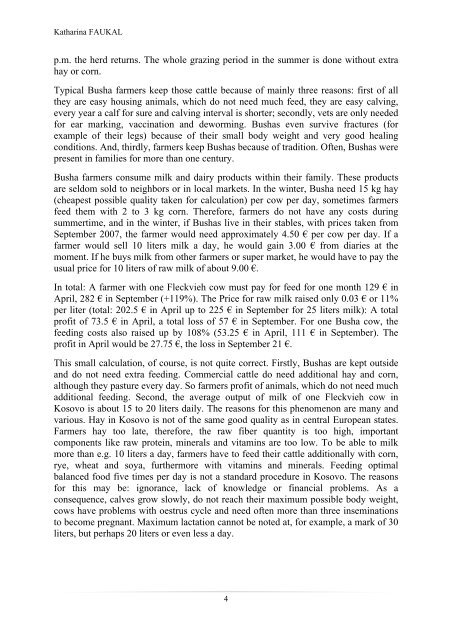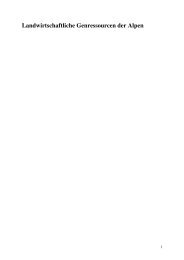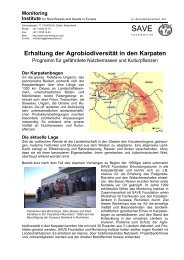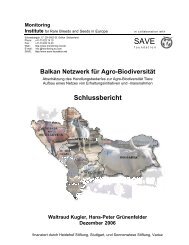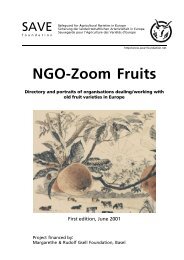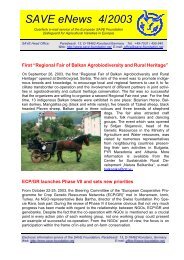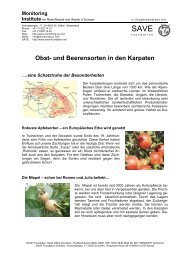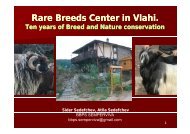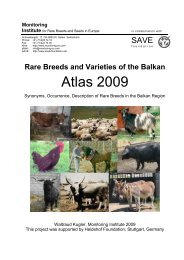The Busha cattle – a breed originated in middle ... - SAVE Foundation
The Busha cattle – a breed originated in middle ... - SAVE Foundation
The Busha cattle – a breed originated in middle ... - SAVE Foundation
Create successful ePaper yourself
Turn your PDF publications into a flip-book with our unique Google optimized e-Paper software.
Kathar<strong>in</strong>a FAUKAL<br />
p.m. the herd returns. <strong>The</strong> whole graz<strong>in</strong>g period <strong>in</strong> the summer is done without extra<br />
hay or corn.<br />
Typical <strong>Busha</strong> farmers keep those <strong>cattle</strong> because of ma<strong>in</strong>ly three reasons: first of all<br />
they are easy hous<strong>in</strong>g animals, which do not need much feed, they are easy calv<strong>in</strong>g,<br />
every year a calf for sure and calv<strong>in</strong>g <strong>in</strong>terval is shorter; secondly, vets are only needed<br />
for ear mark<strong>in</strong>g, vacc<strong>in</strong>ation and deworm<strong>in</strong>g. <strong>Busha</strong>s even survive fractures (for<br />
example of their legs) because of their small body weight and very good heal<strong>in</strong>g<br />
conditions. And, thirdly, farmers keep <strong>Busha</strong>s because of tradition. Often, <strong>Busha</strong>s were<br />
present <strong>in</strong> families for more than one century.<br />
<strong>Busha</strong> farmers consume milk and dairy products with<strong>in</strong> their family. <strong>The</strong>se products<br />
are seldom sold to neighbors or <strong>in</strong> local markets. In the w<strong>in</strong>ter, <strong>Busha</strong> need 15 kg hay<br />
(cheapest possible quality taken for calculation) per cow per day, sometimes farmers<br />
feed them with 2 to 3 kg corn. <strong>The</strong>refore, farmers do not have any costs dur<strong>in</strong>g<br />
summertime, and <strong>in</strong> the w<strong>in</strong>ter, if <strong>Busha</strong>s live <strong>in</strong> their stables, with prices taken from<br />
September 2007, the farmer would need approximately 4.50 € per cow per day. If a<br />
farmer would sell 10 liters milk a day, he would ga<strong>in</strong> 3.00 € from diaries at the<br />
moment. If he buys milk from other farmers or super market, he would have to pay the<br />
usual price for 10 liters of raw milk of about 9.00 €.<br />
In total: A farmer with one Fleckvieh cow must pay for feed for one month 129 € <strong>in</strong><br />
April, 282 € <strong>in</strong> September (+119%). <strong>The</strong> Price for raw milk raised only 0.03 € or 11%<br />
per liter (total: 202.5 € <strong>in</strong> April up to 225 € <strong>in</strong> September for 25 liters milk): A total<br />
profit of 73.5 € <strong>in</strong> April, a total loss of 57 € <strong>in</strong> September. For one <strong>Busha</strong> cow, the<br />
feed<strong>in</strong>g costs also raised up by 108% (53.25 € <strong>in</strong> April, 111 € <strong>in</strong> September). <strong>The</strong><br />
profit <strong>in</strong> April would be 27.75 €, the loss <strong>in</strong> September 21 €.<br />
This small calculation, of course, is not quite correct. Firstly, <strong>Busha</strong>s are kept outside<br />
and do not need extra feed<strong>in</strong>g. Commercial <strong>cattle</strong> do need additional hay and corn,<br />
although they pasture every day. So farmers profit of animals, which do not need much<br />
additional feed<strong>in</strong>g. Second, the average output of milk of one Fleckvieh cow <strong>in</strong><br />
Kosovo is about 15 to 20 liters daily. <strong>The</strong> reasons for this phenomenon are many and<br />
various. Hay <strong>in</strong> Kosovo is not of the same good quality as <strong>in</strong> central European states.<br />
Farmers hay too late, therefore, the raw fiber quantity is too high, important<br />
components like raw prote<strong>in</strong>, m<strong>in</strong>erals and vitam<strong>in</strong>s are too low. To be able to milk<br />
more than e.g. 10 liters a day, farmers have to feed their <strong>cattle</strong> additionally with corn,<br />
rye, wheat and soya, furthermore with vitam<strong>in</strong>s and m<strong>in</strong>erals. Feed<strong>in</strong>g optimal<br />
balanced food five times per day is not a standard procedure <strong>in</strong> Kosovo. <strong>The</strong> reasons<br />
for this may be: ignorance, lack of knowledge or f<strong>in</strong>ancial problems. As a<br />
consequence, calves grow slowly, do not reach their maximum possible body weight,<br />
cows have problems with oestrus cycle and need often more than three <strong>in</strong>sem<strong>in</strong>ations<br />
to become pregnant. Maximum lactation cannot be noted at, for example, a mark of 30<br />
liters, but perhaps 20 liters or even less a day.<br />
4


